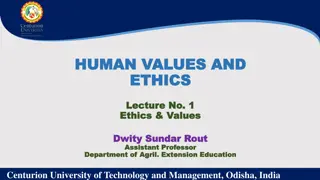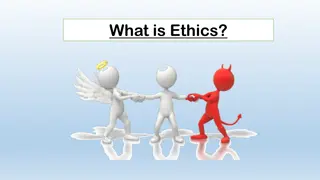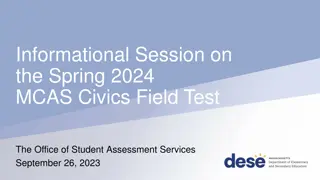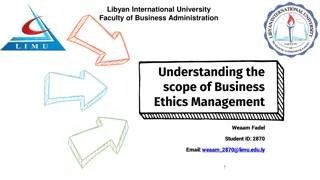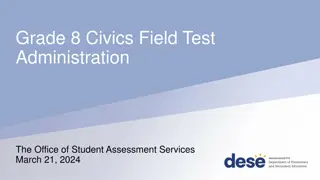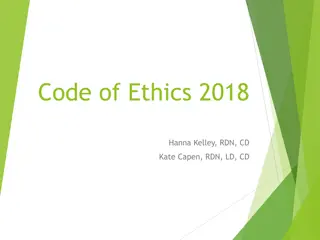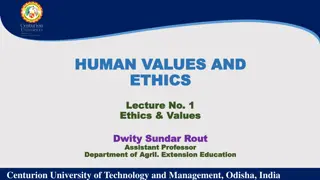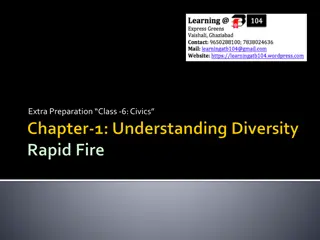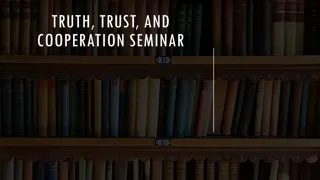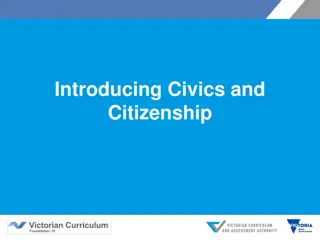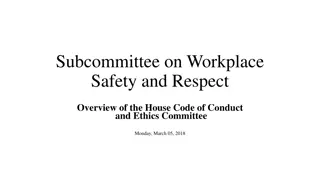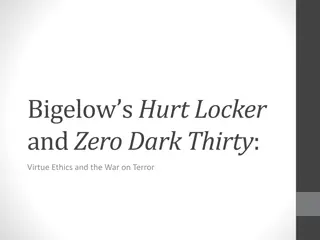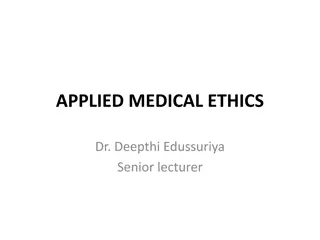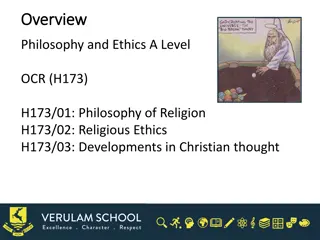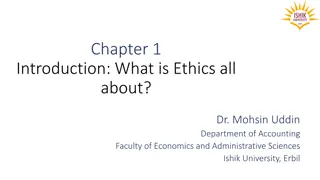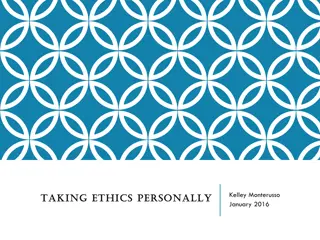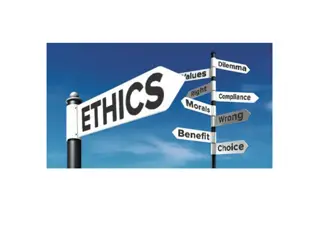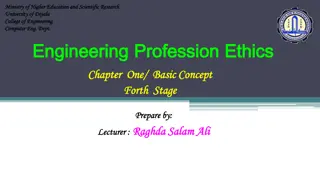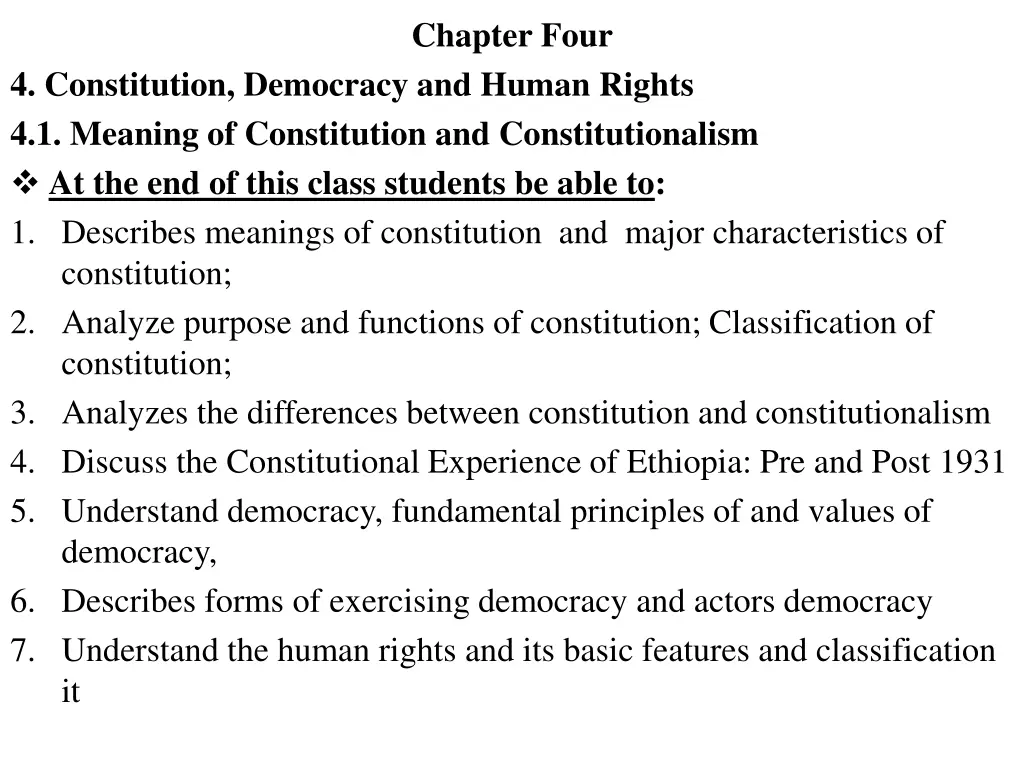
Understanding Constitution, Democracy, and Human Rights
Explore the meanings of constitution and constitutionalism, the purposes and functions of a constitution, and the essence of democracy and human rights. Delve into the constitutional experience of Ethiopia, different forms of democracy, and the fundamental principles of human rights. Gain insights into the major characteristics of constitutionalism, the role of government in upholding the constitution, and the significance of accountability and decentralization of power.
Download Presentation

Please find below an Image/Link to download the presentation.
The content on the website is provided AS IS for your information and personal use only. It may not be sold, licensed, or shared on other websites without obtaining consent from the author. If you encounter any issues during the download, it is possible that the publisher has removed the file from their server.
You are allowed to download the files provided on this website for personal or commercial use, subject to the condition that they are used lawfully. All files are the property of their respective owners.
The content on the website is provided AS IS for your information and personal use only. It may not be sold, licensed, or shared on other websites without obtaining consent from the author.
E N D
Presentation Transcript
Chapter Four 4. Constitution, Democracy and Human Rights 4.1. Meaning of Constitution and Constitutionalism At the end of this class students be able to: 1. Describes meanings of constitution and major characteristics of constitution; 2. Analyze purpose and functions of constitution; Classification of constitution; 3. Analyzes the differences between constitution and constitutionalism 4. Discuss the Constitutional Experience of Ethiopia: Pre and Post 1931 5. Understand democracy, fundamental principles of and values of democracy, 6. Describes forms of exercising democracy and actors democracy 7. Understand the human rights and its basic features and classification it
4. Constitution, Democracy and Human Rights 4.1. Meaning of Constitution and Constitutionalism What is Constitution? The fundamental/ supreme laws of a country/ the land. The basic law of a state which sets out how the state will be organized, the power and authorities of government between different political units, and by stating and the basic principles of the society. The fundamental and organic law of a state that establishes the institution and system of government, defines the scope of governmental sovereignty powers, and grantees individual civil rights and civil liberates. It includes basic rules, regulations, values, beliefs, traditions, norms, customs, standards and aspirations country and give direction to country s foreign relation.
What is Constitutionalism? A doctrine that government should be faithful to their constitution. It means that every action of the government should be accordance with constitution. A country may have a constitution, but that country constitutionalism may not necessarily exist. Protect and respect for human rights/ dignity as its central principle.
The major characteristics of constitutionalism: When the government and its officials are accountable and responsible for their actions. The constitution should, moreover, be considered superior to other laws and be enforced within a legal system with independent courts. It has constitutionally limited government The power of the legislature and executive under some restraints There must be decentralization of power There must be prevalence of law when there is check and balance between the three organs of government.
4.2. Purposes and Functions of Constitution A. Serves as a framework for government: constitution is a plan for organizing composition and structures of a government. It establishes foundation for government. B. Grants powers to government: constitution provides authority to government to accomplish its tasks and to make different decisions. C. Constitution limits government powers: constitution determines what public authorities must do and must not do. It restricts extent or degree of officials power. Government authorities should not do whatever they wish to do but according to their constitution.
D. Constitution as the supreme law of a country Constitution is the source of all specific laws. All other laws are derived from the constitution. All laws in the country must confirm to the constitution. Any law that contradicts with the constitution will not be valid as a law in the country. Thus, constitution serves as a binding instrument of all other laws in a country.
4.3. Formulation, Content and Validity of Constitution Formulation:- It is a matter of making the laws that are going to govern the over all aspects of life in society. A. In non-democratic System of Government few who are in power. It would not reflect the interests and needs of the people at large. Majority citizens have little chance to contribute and shape the constitution. B. In the Democratic system of government Constitution involves active participation of majority of citizens. Citizens give their comments, advises and suggestions in order to improve the draft.
Such constitution is called Law made by citizens, It can easily get public support or approval and It can gate public legitimacy or validity. It help the progress and development of a country and the betterment of the lives of citizens. It also helps to maintain internal peace and stability of the nation. All constitutional provisions are not eternal or not remain acceptable forever.
4.4. Classification/types/forms of Constitution A. Based on its form 1. Written Constitution 2. Unwritten Constitution B. Based on amending process 1. Rigid and 2. Flexible C. Based on degree of practice 1. Effective Constitution 2. Nominal constitution D. Based on the kind of state structure 1. Federal Constitution 2. Unitary Constitution
What is written Constitution The basic principles and rules specifying the rights and duties of citizens found compiled together in a single legal, handy and readable document. Most constitution of states of the world is written constitution. Advantages of written constitution: clear and definite. people have a clear understanding about the powers of the government. rights of the people are secure. citizens have easy access to their constitution and make reference to it in monitoring the behavior to their government Disadvantages of written constitution: It fails to adapt itself to changing conditions easily. It is rigid and may hinder the growth of the country.
Unwritten Constitution Is a set of rules, regulations declarations and laws passed by either a parliament or other competent bodies at different time that are not collected in a single document. Instead these exist in a number of documents, customs and provisions. Advantages of unwritten constitution: Adaptability to changing circumstances and situations. Ensures smooth running of government in accordance with various customs. It recover from shocks that may destroy a codified constitution; Disadvantages of unwritten constitution: It is not accessible to ordinary citizens. It can be changed without the consent of the stakeholders since there is no legal restraints; It is difficult to create awareness through education; and Unsuitable to democracies. Countries like Great Britain, Israel and New Zeland have unwritten constitutions.
i. Rigid amendment procedure. it is difficult to amend immediately, quickly, Rather amendment procedure relatively complex and difficult. Example:- USA, it needs 2/3 majorities in both houses Ethiopia-requires majority support from regional states and 2/3 from both house Advantages of rigid constitution: Rights properly safeguarded; Suited to all kinds of people; Commands the confidence of the people. Disadvantages of rigid constitution: Conservative in character; Undue importance to judiciary; constitution which set-up complex and special
Flexible Constitution:- Amendment procedures are relatively simple. UK; Israel and New Zeland in which the central legislature can easily amend the constitution Advantages of flexible constitution: adaptability country may be saved from revolutions Disadvantages of flexible constitution: unstable It may not be suitable for democracies.
4.6.1. Constitutional Experience of Ethiopia: Pre and Post 1931 4.6.2. pre 1931 Traditional Constitutional Documents There are also some legal documents that are mostly derived from religion, particularly recognized by rulers. These are: A. Kibra Negast B. Fetha Negast C. Seriata Mengist
A. Kibra Negast: Glory of Kings Written in 13thCentury. It was myths of the solomonic dynasty. Solomonic dynasty revolve around the ideas of the divine rights of kings. They claimed to be the chosen people of God to rule. Monarchs elected of God/ born to rule. They could not be accountable to any power, but to God only. This way of justifying king s political power had been used almost by all Ethiopian rulers from 1270-1974.
B. Fetha Negast: This is legal code which has set religious and secular provisions . C. Seriata Mengist: This has provided administrative and protocol directives since 19th c. 5.6.3. Written Constitutions A. The 1931 Written Constitution Ethiopia has the first written constitution. It was a gift by the Emperor to the people. It was a formal agreement between the monarchy and the feudal lords. The Constitution consists seven chapters and 55 articles. More power of the state were given to the emperor. i.e Absolute power by the principle of Divine Rights of Kings..
The two major reason for the foundation of the 1931 constitution is:- 1. Domestic Factor:- the emperor was intending to use the constitution as a legal weapon to centralize all power under his hand (Centralization). 2. Foreign Factor:-to give Ethiopia the image of modernity in the views of westerners(Italy). The innovations of the 1931constitution 1. Bi-cameral parliament a. Chamber of senate b. Chamber of deputies 2. Ministerial system 3. Judiciary system a. Regular court- regulates civil and criminal cases b. Administrative tribunal courts- responsible to handle administrative cases c. Imperial Zufan chillot 4. Financial system-Fixed annual budgetary system
B. The 1955 Revised Constitution Similar to its solidified the absolutism of the monarchy. However, the revised constitution was a much more detailed document containing Articles. Why Emperor Haile Silasse revised the 1931 constitution in 1955, after twenty-four years later? Reasons for the 1955 constitution i. The federation of Eritrea under the sovereign of Ethiopia in 1952 ii. The emperor s desire to settle peace with the then socio- economic and political turmoil of the state. iii. The strong pressure came intellectuals. predecessor the revised Constitution 8 chapters 131 and from Ethiopian young
Change and continuities:- Right to elect deputies-which was previously done by the emperor and nobilities At least there is a textual recognition of the rights and liberties of the people. Independence of judiciary But, Constitution nowhere mentions arrangement. There was no the idea of division and sharing of power. There was no constitutional supremacy and supremacy. Imperial Veto power of the federal popular
C. The 1987 PDRE Constitution-Durge February 1974 government and replaced by military Marxism. After the overthrow of the emperor from his throne in 1974, Ethiopia was led without constitution by a serious of decrees and proclamations. However, 13 years later the military junta came up with the 1987 constitution. The document consisted of 17 chapters and 119 articles. Political Ideology of the State was socialism. Article 2, sub1, which declared PDRE as Unitary state. Accordingly, the country administrative structure was divided in to 29 regions, few of them given autonomous status. monarchy demise the system of
The new innovations of the 1987constitution a. National shengo (The legislature) The national Shengo supreme organ of the state power in the country. The Constitution starts by making the Working People of Ethiopia owners of the Constitution. Local Shengos they establish by election, and referendum. Candidates to the National Shengo were nominated by organs of the Workers' Party of Ethiopia, mass organizations, military units and other bodies. (Parliament) was the
The legislature consists of 835-members The members in the Shengo were elected from their electoral districts in the country. Its members were elected to five-year terms. Sovereignty lies on the workers party of Ethiopia and exercised through the National Shengo. The constitution created the first republic (PDRE). President of PDRE was elected by the National Shengo and answerable to it. He was the head of state
D. The 1991 Transitional Charter May 20, 1991, overthrown by a coalition of liberation forces. The new Ethiopian governors, led by the Ethiopian People s Revolutionary Democratic Front (EPRDF). The ethnic based liberation movements came together immediately at a conference and drafted and approved an interim constitution or the Transitional Charter. The Charter a document with only 20 articles, 5 chapters. The division was based on ethnic and linguistic criteria. The charter allowed the creation of several centers of power and authority.
E. The FDRE Constitution It came into force in August 21, 1995 It has 106 articles and in 11 chapters. Constitution which gives the ownership Nations, Nationalities and Peoples of Ethiopia Established a federal state Dividing and sharing power between the federal and state governments. Two layers of legislative, executive and judicial organs. With bi-cameral Parliament, the upper chamber is the House of the Federation and the lower chamber is the House of People s Representatives.
Members of the upper chamber are elected by the states parliamentary assemblies, whereas members of the lower chamber are elected by popular vote. All recognized national representation in the upper house; Representation in the lower chamber is on the basis of population, with special set-asides for minorities. The major fundamental principles of the 1995 constitution guaranteed groups are 1. Sovereignty of the peoples (Article 8); 2. Supremacy of the constitution (Article 9); 3. Promotion and protection of human (Article 13); 4. secularism (Article 11) and 5. Transparency and accountability of government (Article 12).
4.5. Democracy and Good Governance 4.5.1. Meaning of Democracy May not find exactly one accepted definition or meaning. There is no universally agreed definitions of the term democracy. Democracy is defined in different ways Democracy refers to a political system in which government is from by the people, exercised either directly or through elected representative. Right to give the people to elect their representatives. I.e. considered as the primary source of political power is the people. The government of the people, by the people, and for the people (Abraham Lincoln) i.e. government comes from the people; it is exercised by the people, and for the purpose of the people s own interests.
Majority rule in which minority rights are protected. A system of decision-making in which the leaders are more or less responsible to their deeds. Democracy is a people centered system, where the people are the heart, the root and also the fruits. The Ideas of Democracy is associated with co- existence of ideas, with the right to differ, and with the resolution of ideological differences not by bullet but by ballot. Democracy is also closely associated with peaceful competition of ideas.
4.5.2. Fundamental Principles and Values of Democracy 1. Citizen Participation 2. Equality 3. Political Tolerance 4. Accountability 5. Transparency 6. Regular, Free and Fair Elections 7. Economic Freedom 8. Control of the Abuse of Power 9. Accepting the Results of Elections 10. Human Rights 11. Multi-Party System 12. The Rule of Law
4.5.3 Forms or ways of exercising democracy On the base of its application/exercising democracy have two forms. 1. Direct (participatory democracy) pure 2. Indirect (representative democracy) I. Direct democracy/ pure democracy Direct democracy is characterized by: Allows the people to directly make laws and govern themselves. (people make all the decisions) Allowed all/every citizen to participate in the decision making process. It is Impractical in large populations or countries It applies in small number of people, like kebele, school, clan, tribal organization or local units of labor union.
II. Indirect (representative democracy) 1. Also referred to as a Republican form of government . 2. Works well in large populations when its impractical to bring the entire population together. 3. The people elect officials to make laws, policies, and political decisions for responsibility to pass political decisions on behalf of the people. 4. They are responsible to protect and safeguard interests of the people. 5. When these people/representatives, however, cannot do their jobs, the people have the right to reelect other members. 6. The supreme source of power rests in the people. them. i.e. they have the
4. 5.3. Approaches of understanding democracy There are two views of understanding democracy: procedural substantive views. 4.5.3.1 Procedural Views of Democracy It emphasizes over set of institutions and procedures of democracy, free and fair elections, political equality, fair competition among political parties, legislative assembly and constitutional government. It emphasizes only the procedures and institutions of democracy. These conditions are necessary but not sufficient for democracy. 4.5.3.2. Substantive Views of Democracy In a state some citizens may be more equal than other, and may enjoy a greater voice than other in determining of decision. Poor, less educated, economic disadvantaged citizens who would be unable to fully practice their democratic rights. This type of democracy can also be referred to as a functional democracy.
4.5.4. Actors in democratization process 1. Party system a. One party system b. Two party system c. Multi-party system 2. Interest group 3.Mass media
4.5.6. Democracy and Good Governance 4.5.6.1 The Concept of Good Governance 4.5.6.2 The Relationship of Democracy and Good Governance An enabling legal and regulatory framework Transparency Accountability AnAnti-Corruption environment Active participation
4.6. Human Rights 4.6.1. Understanding Rights What is Rights? It is a legitimate legal, moral or social claims. Human rights are referred as a fundamental rights, basic rights, inherent right, natural rights and birth rights, the rights of man. 4. 6.2. Basic Features of Human Rights 1. Human rights are based on equality 2. Human rights are eternal 3. Human rights are irreducible 4. Human rights are indisputable 5. Human rights are inalienable 6. Human rights are not given by government.
4.6.2. Theories of Right 4.6.2.1. The Natural law Theory Rights belong to man by nature or creature. Rights are universal application irrespective of places, time and environment. Rights have a universal, rational, eternal and immutable character. The basis of natural theory is unchanging moral law. 6.2.2. The Legal Theory Rights are neither absolute nor given by nature or by the Creator. Rights are creations of the law of a state, thus State is the only source of rights. Rights are dynamic-change with the laws of the land. There is no right where there is no power to secure the object of right. 6.2.3. The Idealist/personality Theory Rights exist in the social consciousness, Rights are rooted in the mind of persons. They are powers granted to them by the community. 6.2.4. The Historical Theory Rights are creations of time. The passage of time results in the creation of rights. They are based on the long established customs. 6.2.5. The Social Welfare Theory Rights make what is conducive to the greatest good of the greatest number.
4.6.4. Historical foundation of HRs 1. The 1215 Magna Carta 2. The 1628 Petition of Rights 3. The 1688 Glorious Revolution 4. The Virginia Bill of Rights of 1776 5. The 1789 French Declaration of the Rights of Man and the Citizen 6. The 1917 Bolshevik Revolution in Tsarist Russia
4.6.5. Classifications of Human Rights 4.6.5.1. First Generation Rights It refer to civil and political rights. It also called negative rights. Freedom from racial and other forms of discrimination Freedom from slavery or involuntary servitude Freedom from torture and from cruel, inhumane treatment Freedom from arbitrary arrest, detention or exile; the right to fair and public trial Freedom from interference in privacy and correspondence Freedom of movement and residence Freedom of opinion and expression Freedom of peaceful assembly and association The right to asylum The right to participate in different activities
4.6.5.2. Second Generation Rights It refer to economic, social and cultural rights. It is also called positive rights. The right to social security The right to work and protection against unemployment The right to rest and leisure including periodic holidays leave with pay The right to a standard of living adequate for health and wellbeing of self and family The right to education The right to protection of one s scientific, literary and artistic production 4.6.5.3. Third Generation Rights The right to political, economic and social development The right to participate in and benefit from the common heritage of mankind The right to peace The right to a healthy and balanced environment The right to humanitarian disaster relief
Class Activities: 1. Identify the meanings and differences between constitutional and constitutionalism? 2. Identify purposes and functions of constitutions? 3. Identify the classifications of constitutions? 4. Discuses the constitutional history of Ethiopia: pre 1931 traditional constitution and post 1931 constitutions, with their major characteristics? 5. Discuses the concepts of democracy and its types? 6. Describe and discuses the fundamental principles of democracy? Describes? 7. Understand the relation between principles democracy and good governance? 8. Explain what human rights means and their basic futures? 9. Identify the classifications of human rights and their major characteristics?


